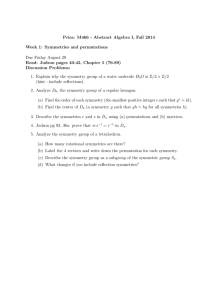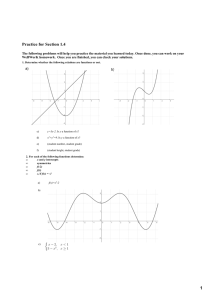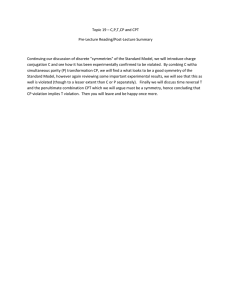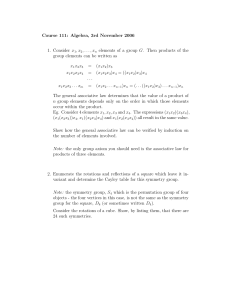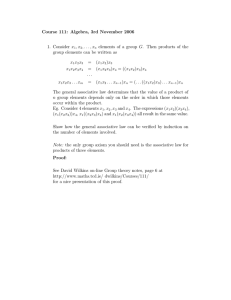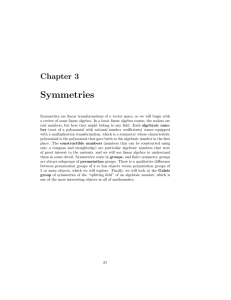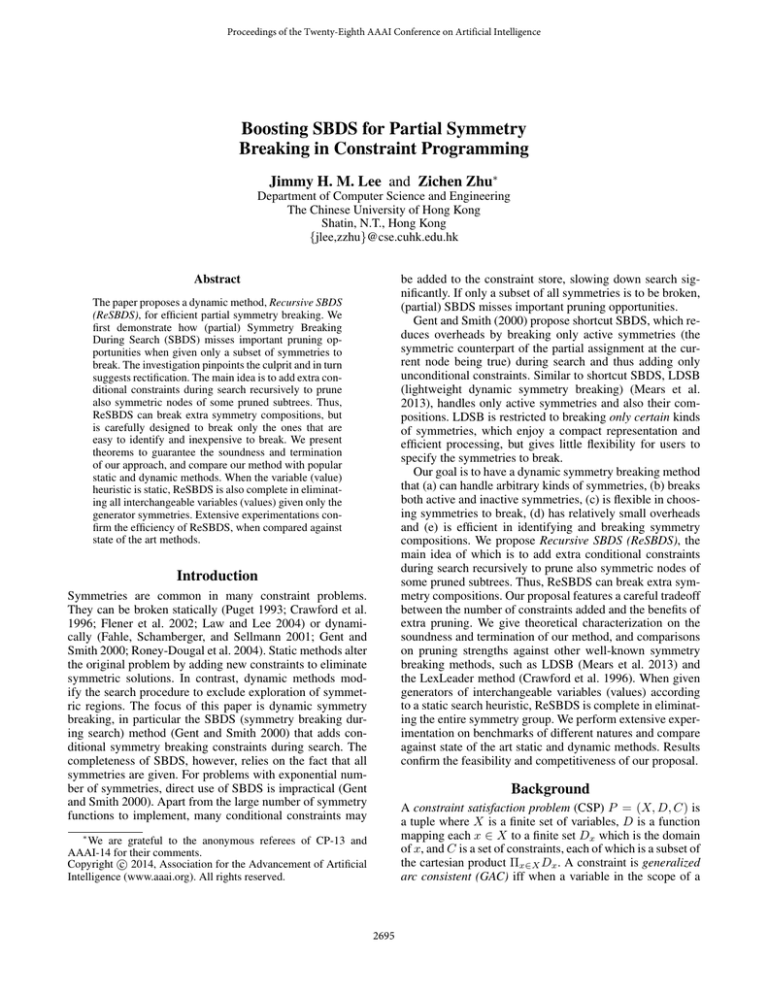
Proceedings of the Twenty-Eighth AAAI Conference on Artificial Intelligence
Boosting SBDS for Partial Symmetry
Breaking in Constraint Programming
Jimmy H. M. Lee and Zichen Zhu∗
Department of Computer Science and Engineering
The Chinese University of Hong Kong
Shatin, N.T., Hong Kong
{jlee,zzhu}@cse.cuhk.edu.hk
Abstract
be added to the constraint store, slowing down search significantly. If only a subset of all symmetries is to be broken,
(partial) SBDS misses important pruning opportunities.
Gent and Smith (2000) propose shortcut SBDS, which reduces overheads by breaking only active symmetries (the
symmetric counterpart of the partial assignment at the current node being true) during search and thus adding only
unconditional constraints. Similar to shortcut SBDS, LDSB
(lightweight dynamic symmetry breaking) (Mears et al.
2013), handles only active symmetries and also their compositions. LDSB is restricted to breaking only certain kinds
of symmetries, which enjoy a compact representation and
efficient processing, but gives little flexibility for users to
specify the symmetries to break.
Our goal is to have a dynamic symmetry breaking method
that (a) can handle arbitrary kinds of symmetries, (b) breaks
both active and inactive symmetries, (c) is flexible in choosing symmetries to break, (d) has relatively small overheads
and (e) is efficient in identifying and breaking symmetry
compositions. We propose Recursive SBDS (ReSBDS), the
main idea of which is to add extra conditional constraints
during search recursively to prune also symmetric nodes of
some pruned subtrees. Thus, ReSBDS can break extra symmetry compositions. Our proposal features a careful tradeoff
between the number of constraints added and the benefits of
extra pruning. We give theoretical characterization on the
soundness and termination of our method, and comparisons
on pruning strengths against other well-known symmetry
breaking methods, such as LDSB (Mears et al. 2013) and
the LexLeader method (Crawford et al. 1996). When given
generators of interchangeable variables (values) according
to a static search heuristic, ReSBDS is complete in eliminating the entire symmetry group. We perform extensive experimentation on benchmarks of different natures and compare
against state of the art static and dynamic methods. Results
confirm the feasibility and competitiveness of our proposal.
The paper proposes a dynamic method, Recursive SBDS
(ReSBDS), for efficient partial symmetry breaking. We
first demonstrate how (partial) Symmetry Breaking
During Search (SBDS) misses important pruning opportunities when given only a subset of symmetries to
break. The investigation pinpoints the culprit and in turn
suggests rectification. The main idea is to add extra conditional constraints during search recursively to prune
also symmetric nodes of some pruned subtrees. Thus,
ReSBDS can break extra symmetry compositions, but
is carefully designed to break only the ones that are
easy to identify and inexpensive to break. We present
theorems to guarantee the soundness and termination
of our approach, and compare our method with popular
static and dynamic methods. When the variable (value)
heuristic is static, ReSBDS is also complete in eliminating all interchangeable variables (values) given only the
generator symmetries. Extensive experimentations confirm the efficiency of ReSBDS, when compared against
state of the art methods.
Introduction
Symmetries are common in many constraint problems.
They can be broken statically (Puget 1993; Crawford et al.
1996; Flener et al. 2002; Law and Lee 2004) or dynamically (Fahle, Schamberger, and Sellmann 2001; Gent and
Smith 2000; Roney-Dougal et al. 2004). Static methods alter
the original problem by adding new constraints to eliminate
symmetric solutions. In contrast, dynamic methods modify the search procedure to exclude exploration of symmetric regions. The focus of this paper is dynamic symmetry
breaking, in particular the SBDS (symmetry breaking during search) method (Gent and Smith 2000) that adds conditional symmetry breaking constraints during search. The
completeness of SBDS, however, relies on the fact that all
symmetries are given. For problems with exponential number of symmetries, direct use of SBDS is impractical (Gent
and Smith 2000). Apart from the large number of symmetry
functions to implement, many conditional constraints may
Background
A constraint satisfaction problem (CSP) P = (X, D, C) is
a tuple where X is a finite set of variables, D is a function
mapping each x ∈ X to a finite set Dx which is the domain
of x, and C is a set of constraints, each of which is a subset of
the cartesian product Πx∈X Dx . A constraint is generalized
arc consistent (GAC) iff when a variable in the scope of a
∗
We are grateful to the anonymous referees of CP-13 and
AAAI-14 for their comments.
c 2014, Association for the Advancement of Artificial
Copyright Intelligence (www.aaai.org). All rights reserved.
2695
m2 ), if all nodes (solutions) pruned by m2 would also be
pruned by m1 . Note that ≥n implies ≥s . If m1 ≥n m2 and
m2 ≥n m1 , then m1 =n m2 , and similarly for m1 =s m2 .
The LexLeader method (Crawford et al. 1996) adds
one lexicographical ordering constraint, ≤lex (Frisch et al.
2002), per variable symmetry according to a fixed variable
order.
Given the set of all symmetries to a CSP, symmetry breaking during search (SBDS) (Gent and Smith 2000) adds conditional constraints for each symmetry upon backtracking.
Consider a node P0 in the search tree with partial assignment A, branching variable x and value v. After backtracking from the node P0 ∪ {x = v}, for each solution symmetry g, SBDS adds the following conditional constraint to the
node P0 ∪ {x 6= v}:
constraint is assigned any value in its domain, there exist
compatible values in the domains of all other variables in the
scope of the constraint. A CSP is GAC iff every constraint is
GAC. An assignment x = v assigns value v to variable x. A
full assignment is a set of assignments, one for each variable
in X. A partial assignment is a subset of a full assignment. A
solution for P is a full assignment that makes every member
of C true.
In order to make sensible comparisons against other methods, we consider only search trees with static variable and
value orderings. A search tree for a CSP P with variables X
is finite and has CSPs as nodes. The root is P . A node P0 is
a leaf node iff either P0 has a variable with empty domain
or the domains of all variables of P0 are singletons. Without loss of generality, we consider search trees with binary
branching, in which every non-leaf node has exactly two descendants. Suppose a non-leaf node P1 has x and v ∈ Dx as
the branching variable and value. The left and right children
of P1 are P1 ∪ {x = v} and P1 ∪ {x 6= v} respectively. Each
node P1 is associated with a partial assignment A1 which is
the set of assignments collected from the root P to P1 .
We assume that the CSP associated with a node is always
made domain consistent. Given a node P0 with branching
variable x and value v. The left child P0 ∪ {x = v} of P0
and the entire subtree are pruned by its ancestor Pk during
search if v is pruned from Dx in Pk . In addition, the right
child of P0 is then merged with P0 .
Here we consider symmetry as a property of the set of solutions. A solution symmetry (Rossi, van Beek, and Walsh
2006) is a solution-preserving permutation on assignments.
A variable symmetry σ is a bijection on variables that preserves solutions: if {xi = vi |1 ≤ i ≤ n} is a solution, then
{xσ(i) = vi |1 ≤ i ≤ n} is also. A value symmetry θ is a
bijection on values that preserves solutions: if {xi = vi |1 ≤
i ≤ n} is a solution, then {xi = θ(vi )|1 ≤ i ≤ n} is also.
A set of variables X (values V ) is interchangeable iff any
bijection mapping from X → X (V → V ) is a variable
(value) symmetry. A symmetry class (Flener et al. 2002) is
an equivalence class of full assignments, where two assignments are equivalent if there is some symmetry mapping one
into the other. Given two nodes P0 and P1 with partial assignments A0 and A1 respectively. P1 is a symmetric node
of P0 w.r.t. symmetry g if Ag0 = A1 .
A set of symmetries G generates a group Σ if every element of Σ can be written as a product of elements in G
with the composition operator ◦ and every product of any
sequence of elements of G is in Σ. G is called a set of generators for Σ, which is in turn the symmetry group of G.
A symmetry breaking method is sound (complete) iff it
leaves at least (most) one solution in each symmetry class.
A symmetry breaking method breaks a symmetry g iff there
exists a remaining solution S after applying this method, S g
is pruned. A symmetry breaking method eliminates a symmetry g iff for each remaining solution S after applying this
method, S g must be pruned. A symmetry breaking method
eliminates a symmetry group Σ iff all symmetries in Σ except the identity symmetry are eliminated.
Symmetry breaking method m1 is stronger in node (solution) pruning than method m2 , denoted m1 ≥n m2 (m1 ≥s
A&Ag &(x 6= v) ⇒ (x 6= v)g
(1)
meaning that once A&(x = v) has been searched, its symmetric partial assignments (A&(x = v))g for any g in the
symmetry set under this subtree should not be searched at
all. Note that Equation (1) can be simplified to Ag ⇒ (x 6=
v)g as A and x 6= v must hold in the subtree to be searched.
If Ag for symmetry g is true at a node with partial assignment A, we call g an active symmetry at this node; otherwise, it is inactive. If Ag for a symmetry g is false at a search
node with partial assignment A, we say g is broken at this
node; otherwise, it is unbroken. Note that SBDS does not
add symmetry breaking constraints for symmetries that are
broken, as the left hand side of (1) is false already.
Partial SBDS and Its Pitfall
Partial SBDS (ParSBDS) is SBDS but handles only a given
subset of all symmetries, which are usually generator symmetries (Flener et al. 2002; Petrie and Smith 2003). In
the following, we analyze how LexLeader (Crawford et al.
1996) is stronger in node (solution) pruning than ParSBDS
when variable and value orders are fixed and both are given
the same subset of symmetries. We use as example the 2×2
unconstrained matrix problem with domain size 2. The symmetries are interchangeable rows and columns, which are
denoted by R and C respectively.
Figure 1 gives the symmetry classes under matrix symmetries of the unconstrained matrix problem with generators {R, C}. Symmetric solutions are connected by lines
with double arrow marked by the corresponding symmetries.
There are 7 symmetry classes. Modeling the problem with 4
variables {x11 , x12 , x21 , x22 }, one for each square with the
domain of each variable being {1, 2}, we can break {R, C}
using the LexLeader method (Crawford et al. 1996) by statically adding two constraints
hx11 , x12 i ≤lex hx21 , x22 i, hx11 , x21 i ≤lex hx12 , x22 i
to choose the lexicographically least solutions according to
the input order (x11 , x12 , x21 , x22 ).
Only 7 solutions are left: 1 , 2 , 4 , 6 , 7 , 8 and 16 .
Solutions 3 and 5 are pruned by 2 . Solution 9 is pruned
by 3 and 5 . Solution 10 is pruned by 7 . Solution 11 is
pruned by 6 . Solution 13 is pruned by 4 . Solutions 12 and
14 are pruned by 8 . Solution 15 is pruned by 12 and 14 .
2696
Ϯ
ϯ
ϭ ϭ
ϭ Ϯ
ϭ ϭ
Ϯ ϭ
ϱ
ϵ
ϰ
ϳ
ϭ ϭ
Ϯ Ϯ
ϭ Ϯ
Ϯ ϭ
ϭϯ
ϭ Ϯ
ϭ ϭ
ϴ
ϭϮ
ϭ Ϯ
Ϯ Ϯ
Ϯ ϭ
Ϯ Ϯ
ϭϬ
Ϯ Ϯ
ϭ ϭ
Ϯ ϭ
ϭ ϭ
which is symmetric to 8 by simply composing R and C.
We compare ParSBDS and LexLeader theoretically by
considering only symmetries of the form σ ◦ θ, which are
compositions of a variable symmetry σ and a value symmetry θ. Such symmetries σ ◦ θ are common in practice (variable and value symmetries are special cases) and are bijections on assignments that preserve solutions: if {xi = vi |1 ≤
i ≤ n} is a solution, then {xσ(i) = θ(vi )|1 ≤ i ≤ n} is also.
Note σ◦θ = θ◦σ. LexLeader breaks value symmetries using
the element constraint (Puget 2006b).
With a proof technique similar to that by Puget (2006a) in
comparing SBDS and dynamic lex constraints, we give the
following theorem.
Ϯ ϭ
ϭ Ϯ
ϲ
ϭϭ
ϭ Ϯ
ϭ Ϯ
Ϯ ϭ
Ϯ ϭ
ϭ
ϭϲ
ϭϱ
ϭϰ
Ϯ Ϯ
Ϯ ϭ
Ϯ Ϯ
ϭ Ϯ
ϭ
ϭ
Ϯ
Ϯ
ϭ
ϭ
Ϯ
Ϯ
Theorem 1. Given a set of symmetries G. LexLeader ≥n
ParSBDS and LexLeader ≥s ParSBDS when both search
with the same static variable order used by LexLeader and
min (max) value ordering.
Figure 1: Symmetry classes of the unconstrained matrix
problem with generators {R, C}.
The ParSBDS method leaves 8 solutions: 1 , 2 , 4 , 6 ,
7 , 8 , 15 and 16 by breaking {R, C} with input variable
order (x11 , x12 , x21 , x22 ) and minimum value heuristic. We
show the depth-first search tree in Figure 2 where each solution leaf node is marked by its solution number. Upon
each backtracking, ParSBDS adds a conditional constraint
Ag ⇒ (x 6= v)g for each unbroken given symmetry g, where
A is the partial assignment of the parent node, and x and v
are the branching variable and value of the parent node respectively. The constraints are labeled by 4.
ϯ
Recursive SBDS
In order to circumvent the pitfall of ParSBDS for a common
class of symmetries, we propose Recursive SBDS, which
adds extra constraints that are easy to derive, inexpensive
to compute and can break many of the composition symmetries. Experimental results show our method can find a
good balance between the number of symmetry breaking
constraints to add and the extra pruning induced.
Consider the problem in Figure 2 again. Being given the
generators {R, C}, ParSBDS will add at most two conditional constraints in each backtracking. Our proposed additional constraints are indicated by .
After backtracking from (a) at (b), as A is empty, both
symmetries are intact. ParSBDS adds x12 6= 1 and x21 6= 1.
After 1 is pruned from Dx12 , symmetric nodes P0 containing partial assignment x12 = 1 are thus pruned in the subtree. Why should we not also prune P0 ’s symmetric nodes?
Adding (x12 6= 1)R , we get x22 6= 1. Solution 15 is pruned.
Since x12 6= 1 is derived from (x11 6= 1)C and C ◦ C is
identity, adding (x12 6= 1)C ≡ x11 6= 1 cannot give us
any new prunings. Continuing with this recursive addition
of symmetry breaking constraints, we add (x22 6= 1)R and
(x22 6= 1)C . This gives no further pruning, and the recursive
addition of constraints is stopped. The extra constraints indicated by in Figure 2 allow us to prune also solution 15 .
Thus symmetry C ◦ R is eliminated.
Given a set of symmetries, breaking the potentially exponential number of all symmetry compositions is expensive in
general. An important lesson we learn from the last example
is that some such compositions can be easy to identify and
break. Generalizing from the example, we give Recursive
SBDS (ReSBDS) as follows.
ϭ
Ϯ
ϰ
ϭ
Ϯ
ϭ
ϲ
ϭϱ
ϳ
ϭ
ϴ
ϭϲ
ϰ
ϭ
Ϯ
ϯ
ϰ
Figure 2: Search tree of the unconstrained matrix problem
by breaking generators {R, C}.
LexLeader can prune solution 15 but ParSBDS cannot.
LexLeader prunes 15 because it is lexicographically larger
than 12 and 14 . For ParSBDS, after backtracking from node
(a) at node (b) in Figure 2, symmetry breaking constraints
prune value 1 from Dx12 and Dx21 . Solutions 12 and 14
are thus pruned. There would not be any backtracking from
these pruned nodes in the subtree of (b). However, ParSBDS
is triggered to add symmetry breaking constraints only by
backtracking. Thus, no constraints are added to prune 15 ,
1. Given the input symmetries G. Upon each backtracking,
ReSBDS adds conditional constraints added by ParSBDS.
2. ReSBDS maintains a backtrackable set T of assignments,
which is initially empty at the root node. Whenever ReSBDS adds a conditional constraint, Ag ⇒ (x 6= v)g
(where g ∈ G), we add the following into T :
• each (xi = vi ) ∈ Ag , and
2697
Pn−1
Proof. The maximum size of T is i=0 D(xi ), which is
the number of all possible assignments for the CSP P .
• (x = v)g .
3. After constraint propagation at every node P0 with partial
assignment E during search, ReSBDS performs:
Theorem 4. ReSBDS is sound.
• For each violated (xi = vi ) ∈ T
– add E h ⇒ (xi 6= vi )h for ∀h ∈ G
– delete (xi = vi ) from T in P0 ’s subtree
– update T accordingly as in Step 2
• Initiate constraint propagation and repeat Step 3 if there
is pruning; otherwise, go on branching.
Proof. Gent and Smith (2000) prove that partial SBDS does
not exclude the solution occurring at the leftmost position
in the search tree of every symmetry class. The extra breaking constraints added by ReSBDS are used only to prune
the symmetric equivalent subtrees of pruned subtrees which
either contain no solutions or solutions symmetric to the leftmost solution discovered earlier.
Since T is backtrackable, when the search backtracks, modifications to T must be undone. We elaborate the meaning of
T briefly in the following.
There are two different reasons for ReSBDS to add a conditional constraint Ag ⇒ (x 6= v)g for some g ∈ G at a
node P0 . First, ReSBDS follows ParSBDS to add a symmetry breaking constraint upon backtracking. Second, P0 has
partial assignment A with v being pruned from Dx by constraint propagation. ReSBDS needs to detect when exactly
the intended symmetric nodes to prune for an added conditional constraint are actually pruned. To achieve this, we
record in T all the assignments whose violations can indicate that Ag ⇒ (x 6= v)g is already satisfied, in which case
all nodes containing the partial assignments Ag &(x = v)g
under the subtree of P0 are pruned.
At every node after constraint propagation, Step 3 of ReSBDS checks T to see if any stored assignment is violated.
Suppose node P1 has partial assignment E with vi being
pruned from Dxi and (xi = vi ) ∈ T . It means that every node Ps in the subtree of P1 containing partial assignments E&(xi = vi ) are pruned. Suppose xi = vi is added
to T because of the previously posted conditional constraint
Ag ⇒ (x 6= v)g . Ps is associated with the partial assignment As . Consider all assignments xj = vj (which can be
none) in Ag &(x = v)g but not in E. Therefore, xj = vj
can be true or false in As . If all such assignments are true
in As , Ps is a symmetric node of a previously visited or
pruned node w.r.t. g, which is intended to be pruned by
Ag ⇒ (x 6= v)g . Posting E h ⇒ (xi = vi )h can potentially
break g ◦ h (when this constraint has pruned a solution) for
all h ∈ G. Otherwise, Ps is just an ordinary pruned node.
Posting E h ⇒ (xi = vi )h to prune the symmetric nodes
of such ordinary pruned nodes is sound but not useful for
breaking compositions.
Similar to SBDS, ReSBDS does not add symmetry breaking constraints for broken symmetries. Now we give theorems on the termination, space complexity, soundness, and
pruning strength of ReSBDS over ParSBDS.
Theorem 5. Given the same set of symmetries. ReSBDS ≥n
ParSBDS and ReSBDS ≥s ParSBDS when both use the same
static variable and value orderings.
Proof. All constraints added by ParSBDS are also added by
ReSBDS.
ReSBDS is stronger in solution pruning than LexLeader
when we consider only symmetries that are compositions
σ ◦ θ of a variable symmetry σ and a value symmetry θ.
Theorem 6. Given the same set of symmetries. ReSBDS ≥s
LexLeader when both search with the static variable ordering used by LexLeader and min (max) value ordering.
Sketch of Proof. We prove that all symmetric solutions
pruned by LexLeader will also be pruned by ReSBDS. Suppose a solution s1 is pruned by LexLeader at a node P1 .
There must exist a solution s2 symmetric to s1 and s2 <lex
s1 . Suppose s1 cannot be pruned by ReSBDS. With the same
search heuristic, s2 or its ancestor should be searched earlier
than s1 . There are two cases to consider. If s2 is not pruned,
symmetry breaking constraints added because of backtracking would prune s1 . If s2 is pruned by some conditional
symmetry breaking constraints, ReSBDS would record the
partial assignments in these constraints. Symmetry breaking constraints added because of violation of these recorded
assignments would prune s1 . Both cases contradict the assumption. The theorem is proved.
The DOUBLELEX (Flener et al. 2002) method, a special case of LexLeader, breaks adjacent rows and columns
interchangeability in matrix problems when searching with
row-wise or column-wise variable ordering and min (max)
value ordering.
Corollary 1. ReSBDS ≥s DOUBLELEX.
ReSBDS is, however, not stronger in node pruning than
LexLeader. Consider the CSP with variables {x1 , . . . , x6 }
and {1, 2, 3} as domains. The constraint is: x1 + x2 + x3 =
x4 + x5 + x6 . There are several variable symmetries. Here
we consider only the symmetry mapping xi onto x7−i .
LexLeader adds constraint hx1 , . . . x6 i ≤lex hx6 , . . . , x1 i at
the root node to break this symmetry. ReSBDS adds conditional symmetry breaking constraints during search.
Both ReSBDS and LexLeader return 84 solutions, but
LexLeader has 175 nodes in the search tree while ReSBDS
has 187. We shall demonstrate empirically in our experiments that ReSBDS prunes many more symmetric solutions
than LexLeader in practice, and thus also more search space.
Theorem 2. Step 3 of ReSBDS always terminates.
Proof. The number of all possible assignments is limited.
Once an assignment in T is violated, the assignment will be
removed from T under the subtree. Thus Step 3 of ReSBDS
will always terminate.
Theorem 3. Given a CSP P = (X, D, C) with |X| = n.
Pn−1
The maximum size of T is i=0 D(xi ).
2698
Even when ReSBDS is given only generators, it can be
complete in specific situations.
are not compared since we do not have their implementations in Gecode. These two methods are complete but the
overhead is big in general. We also skip comparing against
SNAKELEX (Grayland, Miguel, and Roney-Dougal 2009),
which is another partial symmetry breaking method using LexLeader. Literature results (Katsirelos, Narodytska,
and Walsh 2010) show it has similar efficiency as DOUBLELEX. All experiments are conducted using Gecode
Solver 4.2.0 on Xeon E5620 2.4GHz processors.
Although Mears et al. (2013) has designed a pattern syntax to specify the input symmetries for LDSB, the syntax
is not available in the Gecode implementation, which gives
only a restricted syntax to specify the types of symmetries
and parameters. It is unclear exactly what symmetries are
processed by LDSB. In subsequent sections, we state only
the types of symmetries given to LDSB in our experiments.
In our tables, #s denotes the number of solutions, #f
denotes the number of failures (number of failed leaf nodes)
and t denotes the running time. An entry with the symbol
“ − ” indicates that the search timed out after the 1 hour
limit. The best results are highlighted in bold. Unique uses
SBDS to break all symmetries. Doublelex lexicographically
orders the rows and columns in increasing order. ParSBDS,
LDSB and ReSBDS handle the given symmetries by ParSBDS, LDSB and ReSBDS respectively. Unless otherwise
specified, the search order is defaulted to input variable order
and minimum value order.
Theorem 7. Given a fixed variable (value) ordering γ. Suppose G is the set of symmetries such that adjacent variables
(values) are interchangeable. Applying ReSBDS on G and
searching with the γ variable (value) ordering eliminates all
symmetries in Σ, where Σ is the symmetry group of G.
Sketch of Proof. For interchangeable variables, LexLeader
can eliminate Σ by being only given G according to any γ
ordering. For interchangeable values, Walsh (2007) proves
VALSYMBREAK(G,X) eliminates Σ, where VALSYMBREAK is a global constraint generated from LexLeader.
Thus, results follow directly from Theorem 6.
LDSB (Mears et al. 2013) is a further development of
shortcut SBDS (Gent and Smith 2000), which is a light version of SBDS by considering only active symmetries. LDSB
handles only active symmetries and also their compositions.
In addition, when v is pruned from variable x, for every
active symmetry f , LDSB not only asserts (x 6= v)f but
also (x 6= v)f ◦g for each active symmetry g. This recursive
step is repeated in a breadth-first manner until no more new
prunings are obtained (Mears et al. 2013). LDSB is close in
spirit to ReSBDS, has smaller overhead but also misses important pruning opportunities. We give theorems to compare
the node and solution pruning power of ReSBDS and LDSB.
Since LDSB (Mears et al. 2013) can deal only with variable
symmetries and value symmetries, we restrict our attention
to these symmetries.
N -Queens
Theorem 8. Given the same set of symmetries to ReSBDS
and LDSB. Suppose both use the same static variable and
value orderings. If all unbroken symmetries at each node
during search are active symmetries, ReSBDS =n LDSB and
ReSBDS =s LDSB, otherwise, ReSBDS ≥n LDSB and ReSBDS ≥s LDSB.
We model the N -Queens problem the standard way using
one variable per column. All 8 geometric symmetries are
given to Unique. We give ParSBDS and ReSBDS only the
two generators rx (reflection on the vertical axis) and d1
(reflection on the diagonal), which can generate all 8 geometric symmetries. LDSB can only handle the rx, ry, r180
symmetries, which are reflections on the vertical and horizontal axes and rotation of 180 degrees. They form a symmetry group. Following Mears et al. (2013), we give LDSB
only the two generators rx and ry.
Table 1 shows the results. Being given two symmetries,
ReSBDS enjoys over 36% reduction in solution size and
over 62% in failures when compared to ParSBDS. In terms
of runtime, ReSBDS is almost 2 times faster. This shows
the additional constraints we add can break more compositions and prune more symmetric subtrees in an efficient way.
Unique eliminates the symmetries in N -Queens completely
and has the smallest solution size and search tree. ReSBDS,
which breaks the symmetries only partially, is 1.6 times
faster than Unique. This shows partial symmetry breaking
method can be efficient even for polynomially symmetric
CSPs (McDonald and Smith 2006). LDSB performs worse
than ParSBDS in search tree size and runtime. This example
demonstrates the main advantages of ReSBDS: flexibility in
choosing symmetries to break, and good balance in overhead
and extra pruning. For ReSBDS, the maximum size of T is
2. In at least 99.99% of the cases, the size of T is 0.
Sketch of Proof. If all unbroken symmetries are active, both
methods add only unconditional symmetry breaking constraints and we can easily check that ReSBDS and LDSB
add exactly the same constraints to prune the same nodes
and solutions.
Otherwise, LDSB breaks only active unbroken symmetries, but ReSBDS breaks also inactive unbroken symmetries
and their compositions. Hence, ReSBDS is stronger.
Experimental Results
This section gives three experiments. In case of partial symmetry breaking, the symmetries to break are chosen according to the standard generators suggested in the literature.
SBDS and ParSBDS share the same code base as the ReSBDS implementation. We compare ReSBDS against ParSBDS and LDSB as well as state of the art static symmetry breaking methods. We also compare against symmetry
breaking with lazy clause generation (Chu et al. 2011) indirectly using results from the literature since we do not
have access to the implementation. GAP-SBDS (Gent, Harvey, and Kelsey 2002) and GAP-SBDD (Gent et al. 2003)
2699
Table 1: N -Queens (all solutions)
N
#s
14
45,752
15
285,053
16 1,846,955
17 11,977,939
Unique
ParSBDS
LDSB
ReSBDS
#f
t
#s
#f
t
#s
#f
t
#s
#f
t
823,621
4.60
140,438
1,361,836
4.75
99,883
1,454,958
5.85
51,876
875,600
2.69
4,825,631
25.53
859,654
7,951,827
30.49
613,978
8,452,568
33.69
324,173
5,131,707 15.99
30,221,334 161.64 5,646,963 50,928,933 182.14 3,985,771 53,277,940 216.16 2,071,568 31,934,685 101.58
200,005,686 1,127.83 36,078,885 337,758,336 1,242.52 25,549,837 351,039,264 1,469.31 13,388,788 211,409,624 694.73
Error Correcting Code - Lee Distance (ECCLD)
so that ReSBDS only adds unconditional constraints. LDSB
is given the interchangeable variables and values.
For the three static methods, smallest domain first heuristic is used. For ReSBDS and LDSB, the variable ordering
heuristic chooses the variable with the most constraints and
breaks ties by the size of the partition containing the variables. This can make more symmetries being active at the
upper level. Due to space limitation, we do not show the
results of running the three static methods with this search
heuristic as the heuristic does not improve the performance.
The ECCLD problem is prob036 in CSPLib (Gent and
Walsh 1999). We follow Lee and Li (2012) in the modeling and turning the optimization problem into a satisfaction
problem to illustrate the effect on solution set size. We only
try to break a subset of the available matrix symmetries in
the problem. ParSBDS is given the symmetry that any two
rows (columns) are interchangeable. ReSBDS is given interchangeability of adjacent rows (columns). ReSBDSc is
given as symmetries that adjacent rows (columns) are interchangeable and also cartesian-product of adjacent row symmetries and adjacent column symmetries. LDSB is given the
interchangeable rows and columns. Note ParSBDS is given
more symmetries than ReSBDS. Given the same symmetries
as ReSBDS or ReSBDSc , ParSBDS fails to solve most of
the problems within the time limit.
Table 2 shows the results. ReSBDS is again much more
time efficient and breaks more symmetries than ParSBDS.
ReSBDS has a smaller number of solutions and search tree
size than Doublelex. The runtime, however, do not gain
from the smaller search tree size because of the larger overhead of ReSBDS. After given more symmetries, ReSBDSc
has half the number of solutions and failures as those of
Doublelex, and is 1.5 times faster than Doublelex on average. We can also see that LDSB leaves many more solutions
and is drastically less efficient than ReSBDS. This shows
ReSBDS can gain a lot by breaking also inactive symmetries and their compositions. Another advantage over LDSB
is again that ReSBDS has the flexibility of choosing given
symmetries to break. For ReSBDS, the maximum size of T
is 99, and the average size is 5. In 15.7% of the cases, the
size of T is 0.
3
10
Precede
Siglex
Siglexdec
LDSB
ReSBDS
2
10
1
Average Time
10
0
10
−1
10
−2
10
−3
10
20
22
24
26
28
30
32
34
36
38
40
32
34
36
38
40
n
(a) k =8
3
10
Precede
Siglex
Siglexdec
LDSB
ReSBDS
2
10
1
10
Average Time
Concert Hall Scheduling
Concert hall scheduling (Law and Lee 2006) is to choose
among n applications specifying a period and an offered
price to use k identical concert halls, to maximize profit. We
take the benchmarks used by Law and Lee (2007), and test
with k ∈ {8, 10}. The concert halls are interchangeable, and
so are applications within each partition.
We compare against the value precedence constraint (Law
and Lee 2006) for breaking value interchangeability and
≤lex for breaking variable interchangeability (Precede),
S IG L EX constraint (Siglex) for breaking variable and value
interchangeability (Law et al. 2007) and its descendingpartition-size variation (Siglexdec). ReSBDS is given two
symmetries: adjacent variables within each partition being
interchangeable and adjacent values being interchangeable
0
10
−1
10
−2
10
−3
10
20
22
24
26
28
30
n
(b) k =10
Figure 3: Concert hall scheduling (optimal solution)
We do not compare the solution set size since the problem
2700
Table 2: The ECCLD problem (all solutions)
n, c, b
4,4,8
5,2,10
5,6,4
5,6,5
5,6,6
6,4,4
6,4,5
6,8,4
8,4,4
Doublelex
ParSBDS
LDSB
ReSBDS
ReSBDSc
#s
#f
t
#s
#f
t
#s
#f
t
#s
#f
t
#s
#f
t
32,469
839,251
44.09
38,235 1,073,244 86.89
430,079 4,538,862 214.22
25,543
631,717
40.49
15,657
394,468
25.21
87
41,571
5.25
136
94,472 22.81
572,041 8,439,178 735.09
76
33,672
5.31
72
24,653
4.09
710,731
725,837
17.09 849,724
900,549 29.51
770,956
822,157 21.85
530,819
537,118
16.74
344,762
354,993
11.78
1,441,224 5,508,192 123.03 1,661,689 6,523,348 203.20 1,944,489 7,669,846 183.17 1,044,674 4,005,819 115.79
649,864 2,560,522
76.41
297,476 11,709,068 312.95 334,519 13,579,038 541.34
538,688 19,051,585 523.68
221,236 8,553,011 300.59
137,279 5,484,120 196.30
4,698,842 4,139,211 117.11 7,607,152 6,726,710 270.11 13,710,850 10,718,458 348.79 3,746,439 3,278,563 122.12 2,331,405 2,181,802
88.04
29,345,816 73,522,873 1,992.05
- 23,059,956 57,225,832 1,957.51 12,832,628 33,062,865 1,187.37
59,158 2,469,211
37.71
62,380 2,992,204 67.89
64,262 2,588,227 43.72
45,024 1,778,978
36.84
28,382 1,176,239
28.15
35,626,714 48,525,827 1,332.26
- 28,982,779 39,163,464 1,433.60 16,965,773 25,052,546 1,039.86
Concluding Remarks
Table 3: Concert hall scheduling, k = 8
n SBDS-1UIP
Static-1UIP
Our contributions are five fold. First, we have identified
the inadequacy of ParSBDS in pruning symmetric solutions
with respect to LexLeader. Second, we propose ReSBDS
which can utilize symmetry breaking constraints’ information to break extra symmetry compositions with low overhead. Third, we give formally the soundness and termination
of ReSBDS and theoretical comparisons against ParSBDS,
LexLeader, DOUBLELEX and LDSB. Fourth, ReSBDS is
shown to be complete to break all interchangeable variables
(values) given only generators when the variable (value) ordering is fixed. Fifth, we demonstrate empirically the efficiency of ReSBDS against state of the art static and dynamic
methods via extensive experimentation.
McDonald and Smith (2006) have shown how dynamic
methods are affected by variable and value heuristics in
partial symmetry breaking. The ReSBDS method is no exception. Our experiments on concert hall scheduling have
shown how a good heuristic can make ReSBDS much more
efficient than the Siglex method. It is worthwhile to investigate the interaction between ReSBDS and search heuristics.
ReSBDS
Xeon Pro 2.4GHz Xeon Pro 2.4GHz Xeon E5620 2.4GHz
20
22
24
26
28
30
32
34
36
38
40
#f
84
181
275
282
1,611
761
1,522
2,636
3,156
5,053
6,648
t
0.04
0.07
0.10
0.10
0.68
0.27
0.40
1.10
1.40
1.91
2.96
#f
134
183
486
685
1,041
2,300
5,712
4,406
5,707
10,518
18,169
t
0.05
0.07
0.15
0.25
0.42
0.52
1.31
1.60
2.37
3.51
6.40
#f
100
155
172
445
501
987
1,080
4,951
1,941
50,015
2,564
t
0.01
0.01
0.02
0.03
0.04
0.07
0.08
0.20
0.14
1.15
0.25
is optimization in nature. Figure 3 shows the timing results
in graphical form for easy visualization. The horizontal axis
shows instance size, and the vertical axis shows the logarithmic mean time in seconds taken to solve the set of instances
to optimality. Any instance that is not solved within the time
limit is considered to have taken 1 hour for the purpose
of calculating the mean. Results show ReSBDS achieves
the best performance, and Precede and Siglex perform the
worst. ReSBDS is also significantly better than Siglexdec
since ReSBDS has a much lower overhead and collaborates
relatively well with the most-constraining heuristic. LDSB
has similar performance trends as ReSBDS, but is at least 2
times and up to 3.7 times slower than ReSBDS. For ReSBDS, the maximum size of T is 8, and the average size is
1.65. In 19% of the cases, the size of T is 0.
Symmetry breaking with lazy clause generation (Chu et
al. 2011) can also handle this problem well. SBDS-1UIP
and Static-1UIP combine SBDS and static methods with
lazy clause generation respectively. The experiments were
run on different generations of the same processor family,
but with different architectures and threading mechanisms.
Results should not be compared directly, but Table 3 gives
the competitive performance of ReSBDS against the replicated results (Chu et al. 2011) of SBDS-1UIP and Static1UIP implemented with CHUFFED which is one of the best
CSP solvers. This again shows our method can break a large
number of symmetries with a small overhead.
References
Chu, G.; Stuckey, P.; de la Banda, M.; and Mears, C. 2011.
Symmetries and lazy clause generation. In IJCAI’11, 516–
521.
Crawford, J.; Ginsberg, M.; Luks, E.; and Roy, A. 1996.
Symmetry breaking predicates for search problems. In
KR’96, 148–159.
Fahle, T.; Schamberger, S.; and Sellmann, M. 2001. Symmetry breaking. In CP’01, 93–107.
Flener, P.; Frisch, A.; Hnich, B.; Kiziltan, Z.; Miguel, I.;
Pearson, J.; and Walsh, T. 2002. Breaking row and column
symmetries in matrix models. In CP’02, 187–192.
Frisch, A.; Hnich, B.; Kiziltan, Z.; Miguel, I.; and Walsh,
T. 2002. Global constraints for lexicographic orderings. In
CP’02, 93–108.
Gent, I., and Smith, B. 2000. Symmetry breaking in constraint programming. In ECAI’00, 599–603.
Gent, I., and Walsh, T. 1999. CSPLib: a benchmark library
for constraints. In CP’99, 480–481.
Gent, I. P.; Harvey, W.; Kelsey, T.; and Linton, S. 2003.
2701
Generic SBDD using computational group theory. In CP’03,
333–347.
Gent, I. P.; Harvey, W.; and Kelsey, T. 2002. Groups and
constraints: Symmetry breaking during search. In CP’02,
415–430.
Grayland, A.; Miguel, I.; and Roney-Dougal, C. M. 2009.
Snake lex: An alternative to double lex. In CP’09, 391–399.
Katsirelos, G.; Narodytska, N.; and Walsh, T. 2010. On the
complexity and completeness of static constraints for breaking row and column symmetry. In CP’10, 305–320.
Law, Y. C., and Lee, J. 2004. Global constraints for integer
and set value precedence. In CP’04, 362–376.
Law, Y., and Lee, J. 2006. Symmetry breaking constraints
for value symmetries in constraint satisfaction. Constraints
221–267.
Law, Y. C.; Lee, J.; Walsh, T.; and Yip, J. 2007. Breaking symmetry of interchangeable variables and values. In
CP’07, 423–437.
Lee, J., and Li, J. 2012. Increasing symmetry breaking by
preserving target symmetries. In CP’12, 422–438.
McDonald, I., and Smith, B. 2006. Partial symmetry breaking. In CP’06, 207–213.
Mears, C.; de la Banda, M. G.; Demoen, B.; and Wallace,
M. 2013. Lightweight dynamic symmetry breaking. Constraints 1–48.
Petrie, K. E., and Smith, B. M. 2003. Symmetry breaking in
graceful graphs. In CP’03, 930–934.
Puget, J.-F. 1993. On the satisfiability of symmetrical constrained satisfaction problems. In ISMIS’93, 350–361.
Puget, J.-F. 2006a. A comparison of SBDS and Dynamic
Lex Constraints. In SymCon’06, 56–60.
Puget, J.-F. 2006b. An efficient way of breaking value symmetries. In AAAI’06, 117–122.
Roney-Dougal, C. M.; Gent, I. P.; Kelsey, T.; and Linton, S.
2004. Tractable symmetry breaking using restricted search
trees. In ECAI’04, 211–215.
Rossi, F.; van Beek, P.; and Walsh, T. 2006. Handbook of
constraint programming.
Walsh, T. 2007. Breaking value symmetry. In CP’07, 880–
887.
2702


